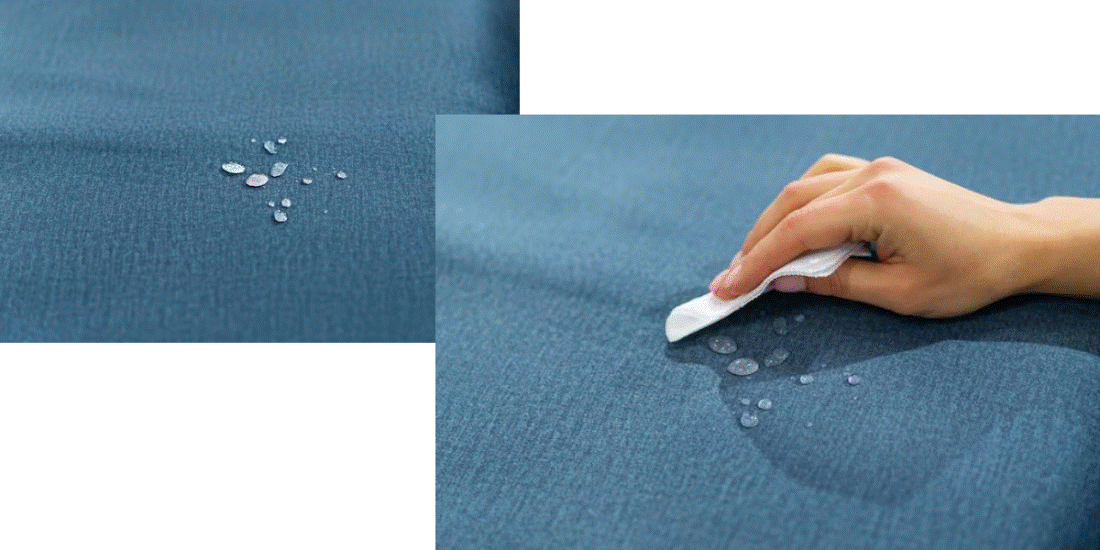
The Importance of Soil Retardancy
Soil retardancy, or soil resistance, is a key attribute in furniture fabrics, ensuring they remain clean, hygienic, and visually appealing over time. This property is particularly valued in both residential and commercial settings, where the frequent use of furniture can lead to significant wear and staining. By repelling dirt, stains, and other contaminants, soil-retardant fabrics offer a range of benefits that contribute to the longevity and maintenance of upholstered furniture.
Enhanced Aesthetic Preservation
One of the primary advantages of soil retardancy in furniture fabrics is the preservation of their appearance. Furniture in high-traffic areas, such as living rooms, offices, and public spaces, is prone to accumulating dirt and stains. Soil-retardant treatments help maintain the original look of the fabric, keeping it clean and new for extended periods. This is crucial in settings where the visual appeal of furniture plays a significant role in the overall ambiance, such as in hotels, restaurants, and corporate offices. Soil-retardant fabrics also retain their color and texture better than untreated fabrics. Regular cleaning and exposure to dirt can cause colors to fade and textures to degrade. By repelling dirt and preventing stains from setting in, soil retardancy helps fabrics retain their vibrant colors and smooth textures, ensuring that furniture remains attractive and inviting.
Reduced Maintenance and Cost Efficiency
Another significant benefit of soil-retardant furniture fabrics is the reduction in maintenance requirements. These fabrics are designed to be easier to clean, often requiring only a simple wipe or light cleaning to remove dirt and stains. This reduces the frequency and intensity of cleaning needed, saving time and effort for homeowners and maintenance staff in commercial settings. The ease of maintenance associated with soil-retardant fabrics also translates into cost savings. Less frequent cleaning means lower expenses on cleaning supplies and services. For businesses, this can result in substantial savings over time, especially in large establishments where maintaining a clean and presentable environment is critical.
Improved Hygiene and Health Benefits
Soil retardancy in furniture fabrics also offers important hygiene and health benefits. In environments such as healthcare facilities, restaurants, and schools, maintaining a clean and hygienic setting is paramount. Soil-retardant fabrics help reduce the buildup of dirt, dust, and allergens on furniture surfaces, contributing to a cleaner environment. By minimizing allergen accumulation, these fabrics can improve indoor air quality and reduce the incidence of allergic reactions among occupants. This is particularly beneficial for individuals with sensitivities to dust and other allergens. In healthcare settings, the ability to repel contaminants also helps reduce the risk of infection and cross-contamination, contributing to a safer environment for patients and staff.

Increased Durability and Longevity
Soil-retardant treatments enhance the durability and longevity of furniture fabrics. By preventing dirt and stains from penetrating the fabric, these treatments reduce the wear and tear associated with frequent cleaning and use. This is especially important for high-investment items such as sofas, armchairs, and office chairs, where prolonged use and exposure to contaminants can significantly shorten their lifespan. Additionally, soil retardancy provides an extra layer of protection against everyday mishaps, such as spills and accidental staining. This makes furniture more resilient to the rigors of daily use, preserving its structural integrity and appearance over time. For businesses, this means less frequent replacement of furniture, resulting in long-term cost savings.
Considerations and Drawbacks of Soil Retardancy
While soil retardancy offers numerous benefits, it is essential to consider the potential drawbacks associated with this property. One of the primary concerns is the use of chemical treatments to achieve soil resistance. Many soil-retardant treatments involve chemicals that can pose health risks, particularly with prolonged exposure. These chemicals may cause skin irritation or allergic reactions in sensitive individuals. Moreover, there are concerns about the long-term health effects of exposure to certain chemicals used in soil-retardant treatments.
The environmental impact of these chemical treatments is another significant consideration. The production and disposal of soil-retardant chemicals can contribute to environmental pollution. Non-biodegradable chemicals can persist in the environment, leading to concerns about their ecological impact. Consumers and businesses increasingly prioritize sustainability, and the environmental footprint of soil-retardant treatments may influence their choices.
Another potential drawback is the higher initial cost of furniture with soil-retardant fabrics. The additional treatment processes required to achieve soil resistance can increase the price of the fabric and, consequently, the overall cost of the furniture. This higher upfront investment may be a barrier for some consumers, especially those on a tight budget.
Over time, the effectiveness of soil-retardant treatments can diminish, necessitating reapplication to maintain their protective properties. This ongoing maintenance can incur additional costs and effort. Moreover, soil retardancy does not make fabrics completely resistant to all types of stains and dirt. Stubborn or oily stains may still penetrate the fabric, requiring regular cleaning. Soil-retardant treatments can also alter the natural feel and comfort of the fabric. These treatments may change the texture or softness of the material, making it less comfortable to touch or sit on. In applications where comfort is a priority, such as in home furnishings or office seating, this can be a significant drawback. Additionally, some soil-resistant coatings can reduce the breathability of the fabric, affecting comfort, particularly in warm climates or in furniture used for prolonged periods.
Conclusion
Soil retardancy is a valuable attribute for furniture fabrics, offering significant benefits in terms of aesthetic preservation, reduced maintenance, improved hygiene, and increased durability. However, it is important to weigh these advantages against the potential drawbacks, including health and environmental concerns, higher costs, and changes to fabric properties. By carefully considering these factors, consumers and businesses can make informed decisions that align with their specific needs and priorities, ensuring that they achieve the desired balance of functionality, comfort, and sustainability in their furniture choices.
